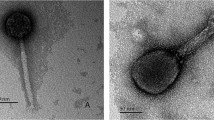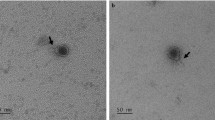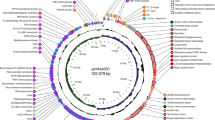Abstract
Two bacteriophages (φBrb01 and φBrb02), lytic toBacteroides ruminicola ssbrevis AR20, were isolated from sewage water. Both phages possessed polyhedral heads and long noncontractile tails, and were classified as Siphoviridae of morphotype B1. Bacteria resistant to phages φBrb01 and φBrb02 arose following lysis of broth cultures. Survivors of φBrb01 infection were capsulated but remained susceptible to φBrb02 infection. Survivors of φBrb02 infection were noncapsulated and were resistant to attack by both φBrb01 and φBrb02. Neither phage lysogenized the host. Both phages contained double-stranded DNA, and their restriction endonuclease digestion patterns indicated that the phage genomes were circularly permuted and terminally redundant. Phage φBrb01 genome was examined in greater detail and confirmed to be circularly permuted, of size 33 kb, with a terminal redundancy of 2 kb, or 6% of the length of the genome. Circularly permuted genomes in phages of rumen bacteria do not appear to have been reported previously.
At present, there is considerable interest in the genetic manipulation of rumen bacteria. The characterization of the phages described herein provides the basic information required for their use in the construction of vectors for the transfer of genetic material.
Similar content being viewed by others
Literature Cited
Ackermann HW, Du Bow MS (1987) Viruses of prokaryotes, Vol 1. General properties of Bacteriophages. Boca Raton, Florida: CRC Press
Booth SJ, Van Tassell RL, Johnson JL, Wilkins TD (1979) Bacteriophages ofBacteroides. Rev Infect Dis 1:325–336
Burt S, Meldrum S, Woods DR, Jones DT (1978) Colonial variation, capsule formation, and bacteriophage resistance inBacteroides thetaiotaomicron. Appl Environ Microbiol 35:439–443
Grund AD, Hutchinson CR (1987) Bacteriophages ofSaccharopolyspora erythraea. J Bacteriol 169:3013–3022
Hudman JF, Gregg K (1989) Genetic diversity among strains of bacteria from the rumen. Curr Microbiol 19:313–319
Jackson EN, Jackson DA, Deans RJ (1978)EcoRI analysis of bacteriophage P22 DNA packaging. J Mol Biol 118:365–388
Kai M, Watanabe S, Furuse K, Ozawa A (1985)Bacteriodes bacteriophages isolated from human feces. Microbiol Immunol 29:895–899
Klieve AV, Bauchop T (1988) Morphological diversity of ruminal bacteriophages from sheep and cattle. Appl Environ Microbiol 54:1637–1641
Klieve AV, Hudman JF, Bauchop T (1989) Inducible bacteriophages from ruminal bacteria. Appl Environ Microbiol 55:1630–1634
Knox MR, Harris JE (1986) Isolation and characterization of a bacteriophage ofMethanobrevibacter smithii strain PS. Abstracts of the XIV International Congress of Microbiology 1986:240
Lockington RA, Attwood GT, Brooker JD (1988) Isolation and characterization of a temperate bacteriophage from the ruminal anaerobeSelenomonas ruminantium. Appl Environ Microbiol 54:1575–1580
Maniatis T, Fritsch EF, Sambrook J (1982) Molecular cloning, a laboratory manual. Cold Spring Harbor, New York: Cold Spring Harbor Laboratory
Molloy PL, Powell BC, Gregg K, Barone ED, Rogers GE (1982) Organisation of feather keratin genes in the chick genome. Nucleic Acids Res 10:6007–6021
Paynter MJB, Ewert DL, Chalupa W (1969) Some morphological types of bacteriophages in bovine rumen contents. Appl Microbiol 18:942–943
Ritchie AE, Robinson IM, Allison MJ (1970) Rumen bacteriophage: survey of morphological types. In: Favard P (ed) Microscopie électronique, vol 3. Paris: Société Française de Microscopie Électronique, pp 333–334
Russell JB, Wilson DB (1988) Potential opportunities and problems for genetically altered rumen microorganisms. J Nutr 118:271–279
Southern EM (1975) Detection of specific sequences among DNA fragments separated by gel electrophoresis. J Mol Biol 98:503–517
Ware CE, Bauchop T, Gregg K (1989) The isolation and comparison of cellulase genes from two strains ofRuminococcus albus. J Gen Microbiol 135:921–930
Woods JR, Hudman JF, Gregg K (1989) Isolation of an endoglucanase gene fromBacteroides ruminicola subsp.brevis. J Gen Microbiol 135:2543–2549
Author information
Authors and Affiliations
Rights and permissions
About this article
Cite this article
Klieve, A.V., Gregg, K. & Bauchop, T. Isolation and characterization of lytic phages fromBacterioides ruminicola ssbrevis . Current Microbiology 23, 183–187 (1991). https://doi.org/10.1007/BF02092277
Issue Date:
DOI: https://doi.org/10.1007/BF02092277




